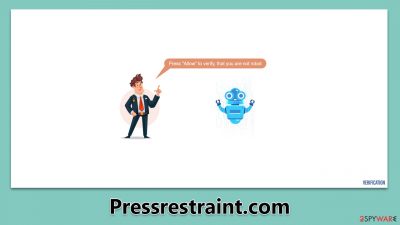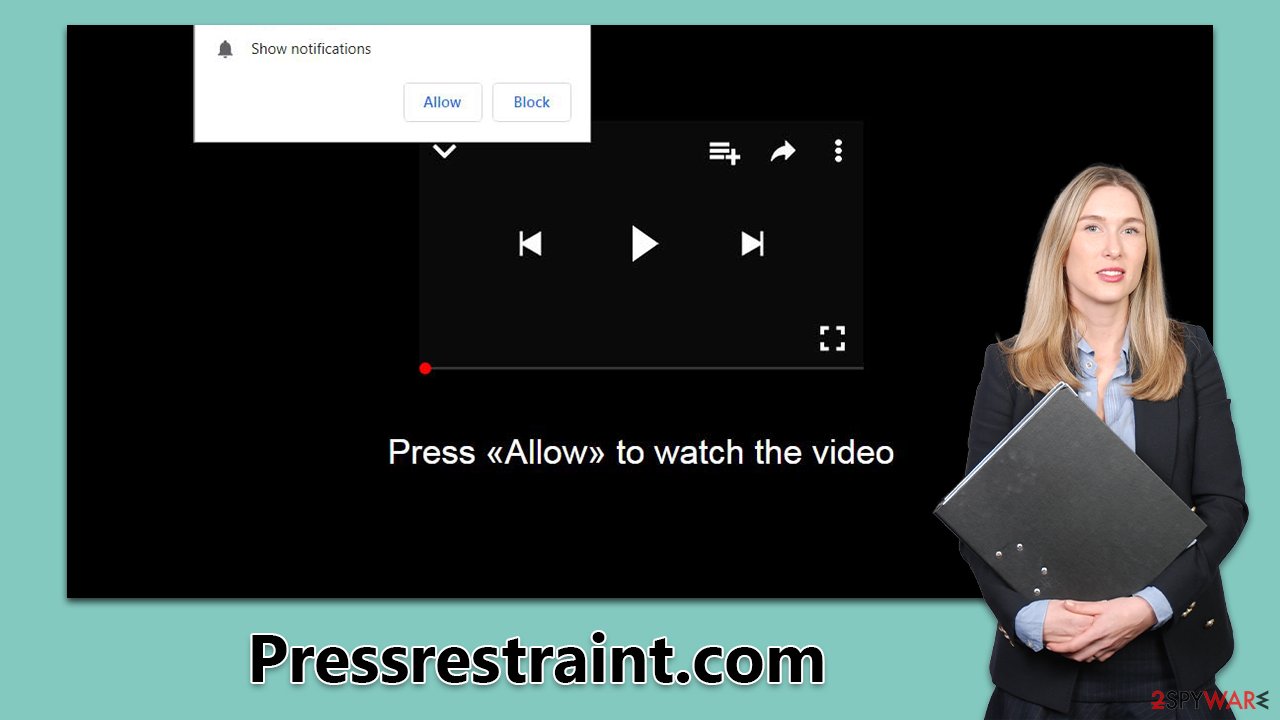Pressrestraint.com ads (scam) - Free Instructions
Pressrestraint.com ads Removal Guide
What is Pressrestraint.com ads?
Pressrestraint.com – a malicious website made by scammers to manipulate users into subscribing

Pressrestraint.com is a push notification scam site that users may stumble upon while browsing on Google Chrome, Mozilla Firefox, MS Edge, or other popular web browsers. It is known for displaying intrusive pop-up ads on users' desktops at unpredictable intervals. This typically occurs after users unintentionally grant the site permission to deliver push notifications, which is often the result of misleading phishing messages shown to them upon visiting the site.
Pressrestraint.com is just one of many such scam websites that users may come across while browsing the internet. It is notorious for showcasing low-quality content primarily because it is connected to disreputable advertising networks and potentially unwanted programs. The push notifications originating from Pressrestraint.com can include links to harmful websites, promote deceptive surveys or get-rich-quick schemes, and falsely claim that the user's computer system has been infected with multiple viruses.
To safeguard yourself from any further complications, it is highly recommended that you refrain from clicking on the promoted hyperlinks and visiting the websites they lead to. To eliminate the annoying push notifications from Pressrestraint.com, it is essential first to confirm that your system is not compromised by adware. Subsequently, adjust your browser settings according to the instructions provided to effectively prevent such notifications in the future.
| Name | Pressrestraint.com |
| Type | Push notifications, ads, pop-ups, scam |
| Distribution | Intrusive pop-ups can start showing up at some point after the “Allow” button is pressed within the notification prompt |
| Symptoms | Pop-ups that are shown include phony notifications and push scams. Links can also direct you to sites filled with malware |
| Risks | The ads shown within push notifications might include misleading messages and links to malicious websites. If clicked, you might end up infecting your system with malware, disclosing your personal information, or losing money |
| Removal | Access browser settings to stop intrusive push notifications. After that, make sure that your system is not infected with adware or malware – scan it with SpyHunter 5Combo Cleaner |
| Repair & tips | Remove caches and other web data to prevent data tracking – use the FortectIntego repair and maintenance tool. You can also repair damaged system components with it |
How crooks operate the scam
It is evident that the majority of users do not intentionally subscribe to receive deceptive content. However, scam websites like Pressrestraint.com employ a range of social engineering techniques to trick and ensnare unsuspecting users, ultimately leading them to fall for their scams.
Once users are redirected to such sites, they are often left confused, as they receive a prompt to click the “Allow” button without sufficient context or explanation. The message requesting permission for push notifications might be presented in various ways, such as:
- Click Allow to verify that you are not a robot.
- Your file is ready for download. Press Allow to proceed.
- If you are over 18, click Allow.
- Just one more step! Click 'Allow' to continue.

These misleading messages are designed to appear genuine, luring users into believing that the request is legitimate and that following the instructions is necessary. Unfortunately, those who comply with the request are typically redirected to another malicious website without ever receiving the promised content or service.
In many cases, nothing seemingly happens immediately after allowing the push notifications, which causes users to disregard the event and carry on with their daily activities. However, they soon discover that their computer screens are inundated with unwanted ads from websites like Pressrestraint.com. These ads can be intrusive, disruptive, and potentially dangerous, creating a frustrating and risky user experience.
Deal with adware and other infections
Those who fall victim to push notification scams may inadvertently expose their devices to adware or other forms of malware. To effectively remove any malicious software and safeguard your system, it is recommended to conduct a thorough system scan using reliable anti-malware programs such as SpyHunter 5Combo Cleaner or Malwarebytes. These security tools are highly efficient in detecting and eradicating all threats in a single sweep. However, before initiating the scan, ensure that your security software's database is current and up-to-date.
After successfully removing any potential threats, it is advisable to clean your web browsers and eliminate any residual files that could lead to the recurrence of unwanted ads or data tracking by external sources. A trusted PC repair tool, such as FortectIntego, can be utilized for this purpose. This tool not only helps eliminate all traces of malware-related damage but also addresses other system issues. As a result, it can prevent critical problems such as Blue Screen of Death crashes and registry errors.
By taking these proactive steps, you can ensure that your device remains free from the harmful effects of adware and other malware. Regularly scanning your system, maintaining up-to-date security software, and using a trusted PC repair tool can significantly reduce the risk of encountering and succumbing to push notification scams and their potential consequences.
Remove Pressrestraint.com ads
While push notifications may appear harmful due to their dubious content, it's essential to understand that they are a native feature of your browser and can be easily managed. The real issue lies with the websites responsible for transmitting these notifications.
Fortunately, you can put an end to receiving these unwelcome alerts with just a few minor adjustments to your web browser settings. Below, we will provide an expanded explanation of how you can achieve this and maintain control over the push notifications you receive.
Google Chrome
- Open the Google Chrome browser and go to Menu > Settings.
- Scroll down and click on Advanced.
- Locate the Privacy and security section and pick Site Settings > Notifications.
- Look at the Allow section and look for a suspicious URL.
- Click the three vertical dots next to it and pick Block. This should remove unwanted notifications from Google Chrome.
![Stop notifications on Chrome PC 2 Stop notifications on Chrome PC 2]()
Google Chrome (Android)
- Open Google Chrome and tap on Settings (three vertical dots).
- Select Notifications.
- Scroll down to the Sites section.
- Locate the unwanted URL and toggle the button to the left (Off position).
![Stop notifications on Chrome Android Stop notifications on Chrome Android]()
Mozilla Firefox
- Open Mozilla Firefox and go to Menu > Options.
- Click on Privacy & Security section.
- Under Permissions, you should be able to see Notifications. Click the Settings button next to it.
- In the Settings – Notification Permissions window, click on the drop-down menu by the URL in question.
- Select Block and then click on Save Changes. This should remove unwanted notifications from Mozilla Firefox.
![Stop notifications on Mozilla Firefox 2 Stop notifications on Mozilla Firefox 2]()
Safari
- Click on Safari > Preferences…
- Go to the Websites tab and, under General, select Notifications.
- Select the web address in question, click the drop-down menu and select Deny.
![Stop notifications on Safari Stop notifications on Safari]()
MS Edge
- Open Microsoft Edge, and go to Settings.
- Select Site permissions.
- Go to Notifications on the right.
- Under Allow, you will find the unwanted entry.
- Click on More actions and select Block.
![Stop notifications on Edge Chromium Stop notifications on Edge Chromium]()
Internet Explorer
- Open Internet Explorer, and click on the Gear icon at the top-right of the window.
- Select Internet options and go to the Privacy tab.
- In the Pop-up Blocker section, click on Settings.
![Stop notifications on Internet Explorer Stop notifications on Internet Explorer]()
- Locate the web address in question under Allowed sites and pick Remove.
How to prevent from getting adware
Choose a proper web browser and improve your safety with a VPN tool
Online spying has got momentum in recent years and people are getting more and more interested in how to protect their privacy online. One of the basic means to add a layer of security – choose the most private and secure web browser. Although web browsers can't grant full privacy protection and security, some of them are much better at sandboxing, HTTPS upgrading, active content blocking, tracking blocking, phishing protection, and similar privacy-oriented features. However, if you want true anonymity, we suggest you employ a powerful Private Internet Access VPN – it can encrypt all the traffic that comes and goes out of your computer, preventing tracking completely.
Lost your files? Use data recovery software
While some files located on any computer are replaceable or useless, others can be extremely valuable. Family photos, work documents, school projects – these are types of files that we don't want to lose. Unfortunately, there are many ways how unexpected data loss can occur: power cuts, Blue Screen of Death errors, hardware failures, crypto-malware attack, or even accidental deletion.
To ensure that all the files remain intact, you should prepare regular data backups. You can choose cloud-based or physical copies you could restore from later in case of a disaster. If your backups were lost as well or you never bothered to prepare any, Data Recovery Pro can be your only hope to retrieve your invaluable files.






